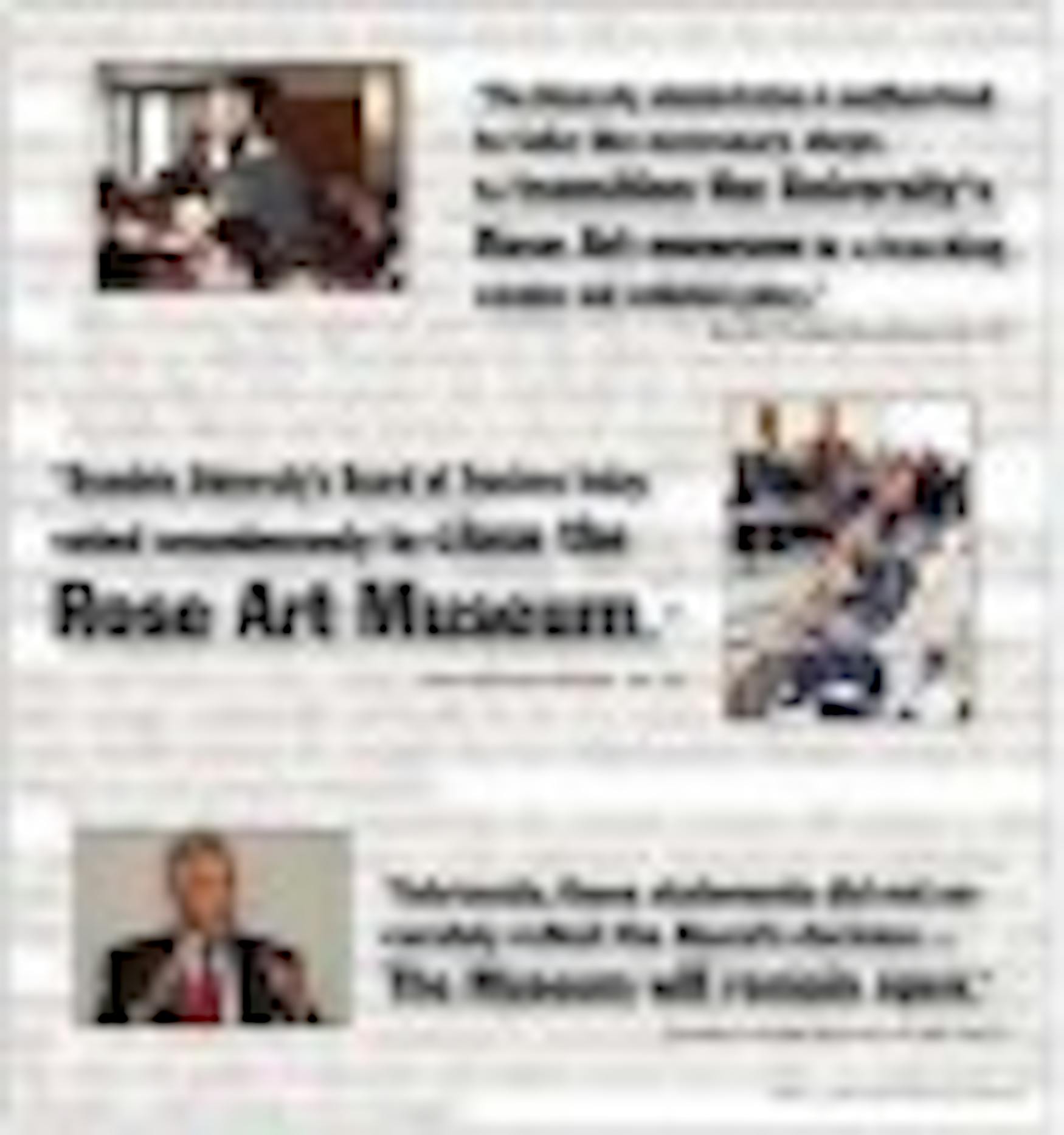ANALYSIS: Semantics over substance
Shifting language confuses Rose decision
It has been nearly one month since the University administration shocked the Brandeis community with an e-mail announcing its decision to close the Rose Art Museum and sell art from its collection. Since the Jan. 26 e-mail announcing the passage of the Board of Trustees' resolution, the decision has been restated to the point where it may seem as if the administration has backed off its initial intentions. But while the language of the initial decision may have changed, the University's intentions have remained the same. The Rose will still transition from a public museum to a teaching space for the school, and the University will still sell the art if necessary in order to help alleviate its financial troubles. The confusion that has permeated the Rose situation lies in the University's words, not its intended actions.
"The new statement from the University president, Jehuda Reinharz, proposes certainly a much milder way of phrasing where we're headed, but I still think we're headed in the same direction," Prof. Eric Hill (THA), the chair of the Committee to Review the Closing of the Rose, told the Justice Feb. 13.
The initial Jan. 26 press release stated that the Board of Trustees "voted unanimously to close the Rose Art Museum," adding that "the University will publicly sell the art collection." Two weeks later, following extensive publicity in national publications like the Boston Globe and the New York Times, Reinharz seemed to backtrack from the original decision in a Feb. 5 e-mail to the Brandeis community. The e-mail read: "The Museum will remain open, but in accordance with the Board's vote, it will be more fully integrated into the University's central educational mission," and also stated that "The [initial public statements] gave the misleading impression that we were selling the entire collection immediately, which is not true." Reinharz blamed himself in part for the misunderstanding, channeling President Barack Obama by writing, "I screwed up."
But Reinharz's second e-mail did not violate the initial Board of Trustees resolution. The original resolution stated, "The University administration is authorized to take the necessary steps to transition the University's Rose Art Museum to a teaching center and exhibition gallery. These steps shall include, to the extent appropriate, review by the Office of the Attorney General of the Commonwealth of Massachusetts and court approval, followed by an orderly sale or other disposition of works from the University's collection." The resolution does not mention the word "close," and as Reinharz said in the first student open forum held Jan. 28 and organized by Student Union President Jason Gray '10, it merely gave the University proper authority to sell art. It did not mandate that the University sell any pieces.
When the decision first broke, Provost Marty Krauss told the Justice that "Ultimately, [closing the Rose] was a decision by the Board, not the administration." Like Reinharz's initial statements, Krauss' words were somewhat misleading. The miscommunication occurred in representing the Board's words in a sufficiently concrete way to the public. As Reinharz wrote in his Feb. 5 e-mail, "[my initial statements] did not accurately reflect the Board's decision."
Reinharz first mentioned this communication failure three days after the original resolution, after the story began to receive attention from national publications. Reinharz said at a Jan. 29 faculty meeting that "no one had anticipated that we could have" what he later called "an avalanche of bad publicity," to audible discontent among the faculty. Prof. Marc Brettler (NEJS) echoed the opinion of many faculty members when he said, "Many of us are worried what kind of mechanisms will be put in place [so a further] public relations disaster does not occur." While the University regretted a part of its decision, its regret was in its miscommunication with the public and not in the content of the decision itself.
And so as students protested the museum's closure and sought answers to their questions at open forums, the faculty voted to establish the Committee to Review the Closing of the Rose, concerned about future University decisions that could lead to similar public outcry. At a second student forum a week after the Jan. 29 faculty meeting, Reinharz seemingly affirmed the CRCR's importance when he told the audience, "How [the Rose] will function is up to the faculty."
But even with the committee's formation, Hill said the University's intentions with the Rose remained as they always have. "I don't necessarily see any changes of course from what the administration originally announced," he said. This interpretation echoed Chairman of the Rose Board of Overseers Jonathan Lee's Feb. 9 comments. "They still intend to sell the art, and they still intend to kill the museum," Lee said.
The confusion therefore emerges out of the University's language in describing its original intentions. Brettler's comments at the Jan. 29 faculty meeting underscore the public's confusion over University semantics. Brettler criticized the administration for saying, "In one official document everything will be sold, in one interview [only some things will be sold], and then today maybe nothing will be sold." The language of the original Board of Trustees resolution, however, did not mandate any of those possibilities.
The only backpedaling that has occurred has been in the interpretation of the original unspecific language of the Board of Trustees resolution, not in the University's intentions. The intent all along appears to have been to end the Rose's tenure as a public museum, sell art to fill funding gaps if the University must do so and instead use the Rose as a studio and teaching space. But the language used has obfuscated the University's actual intentions. "I think this is what you call spin doctoring," Lee told the Justice.



Please note All comments are eligible for publication in The Justice.